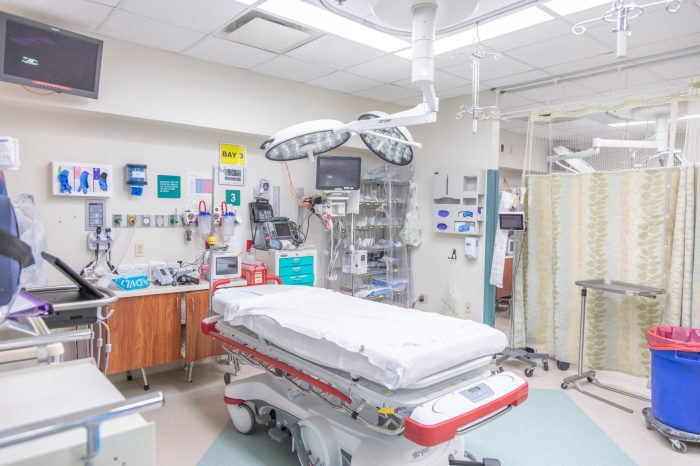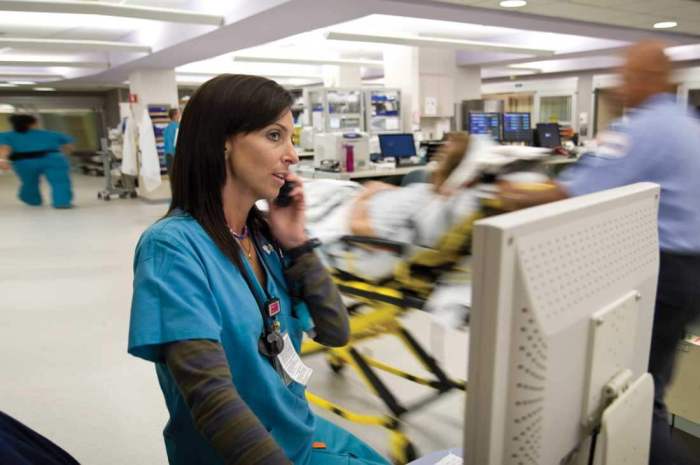
Dive into the world of Emergency Room Healthcare Providers, where we uncover the critical roles, essential qualifications, and demanding responsibilities that shape this vital aspect of healthcare. From saving lives to providing urgent care, these professionals are the backbone of emergency medical services.
As we delve deeper, we unravel the intricacies of emergency room healthcare and the dynamic interplay between nurses, physicians, and physician assistants in delivering prompt and effective medical assistance.
Emergency Room Healthcare Providers
Emergency room healthcare providers play a crucial role in delivering immediate medical care to patients in urgent situations.
Qualifications Required
- A Bachelor’s degree in Nursing or a related field for emergency room nurses
- Medical Doctor (MD) or Doctor of Osteopathic Medicine (DO) degree for physicians
- Master’s degree from an accredited physician assistant program for physician assistants
- Licensure and certification as required by state regulations
Typical Duties and Responsibilities
- Assessing patients’ medical conditions and prioritizing care based on urgency
- Performing diagnostic tests and interpreting results
- Administering medications and treatments
- Collaborating with other healthcare professionals to coordinate patient care
- Maintaining accurate medical records
Differences Between Roles
Emergency room nurses are responsible for direct patient care, monitoring vital signs, and administering medications. Physicians diagnose and treat patients, make medical decisions, and perform procedures. Physician assistants work under the supervision of physicians, providing medical care, conducting physical exams, and prescribing medications.
Healthcare Access
Access to healthcare in emergency room settings is crucial for timely and effective medical intervention. It refers to the ability of individuals to obtain healthcare services when needed, regardless of factors such as location, income, or insurance coverage.Patients may face various challenges in accessing emergency room healthcare services, including long wait times, lack of transportation, financial barriers, and limited availability of specialized care.
These challenges can result in delayed treatment, exacerbation of health conditions, and increased healthcare costs.
Initiatives to Improve Healthcare Access
- Telemedicine programs to provide remote consultations and triage services, reducing the need for in-person visits.
- Community health centers offering primary care services to underserved populations, diverting non-emergency cases away from emergency rooms.
- Care coordination programs to ensure seamless transitions between emergency care and follow-up services, improving continuity of care.
Impact of Healthcare Access
Access to timely and appropriate healthcare services in emergency rooms can significantly impact patient outcomes and overall healthcare system efficiency. Improved access leads to quicker diagnosis and treatment of acute conditions, reducing morbidity and mortality rates. It also helps prevent unnecessary emergency room visits, lowering healthcare costs and alleviating strain on healthcare resources.
Healthcare Costs

Healthcare costs, especially in the emergency room setting, can be a significant financial burden for patients and the healthcare system as a whole. Several factors contribute to the high costs of emergency room healthcare services.
Factors Contributing to High Costs
- Overhead Costs: Emergency rooms are open 24/7 and require a range of specialized equipment and staff to handle any medical situation, leading to high operational costs.
- Uncompensated Care: Many patients who visit the emergency room are uninsured or underinsured, resulting in hospitals absorbing the cost of their care.
- Medical Malpractice Costs: Emergency room healthcare providers often face high malpractice insurance premiums due to the nature of their work, which can drive up overall costs.
Cost Comparison with Other Healthcare Settings
Receiving care in an emergency room tends to be significantly more expensive than seeking treatment in other healthcare settings.
- Urgent Care Centers: Visiting an urgent care center for non-life-threatening conditions can be a more cost-effective alternative to the emergency room.
- Primary Care Physicians: Building a relationship with a primary care physician for routine care and preventive services can help reduce the need for emergency room visits.
Strategies to Reduce Healthcare Costs
- Increasing Access to Primary Care: By improving access to primary care services, patients may seek treatment earlier, preventing the escalation of conditions that require emergency room care.
- Telemedicine Services: Utilizing telemedicine for non-emergent medical issues can help reduce unnecessary emergency room visits and associated costs.
- Care Coordination: Enhancing coordination between healthcare providers to ensure seamless transitions of care can prevent duplicate tests and procedures, ultimately lowering costs.
Implications on Patients’ Decisions
The high costs associated with emergency room care can have significant implications on patients’ decisions to seek medical attention.
- Financial Barriers: Patients may delay or avoid seeking care in the emergency room due to concerns about high out-of-pocket costs, potentially leading to worsened health outcomes.
- Insurance Coverage: The extent of insurance coverage and copayments can influence whether patients choose to visit the emergency room or seek alternative forms of care.
Healthcare Providers

In the fast-paced environment of the emergency room, various types of healthcare providers work together to deliver timely and effective care to patients in need. Collaboration and communication among these providers are crucial to ensure the best outcomes for patients.
Types of Healthcare Providers in the Emergency Room
- Emergency Room Physicians: These are doctors specialized in emergency medicine who lead the team in diagnosing and treating patients in the emergency room.
- Nurses: Registered nurses and nurse practitioners play a vital role in triaging patients, administering medications, and providing direct care under the direction of physicians.
- Emergency Medical Technicians (EMTs): These professionals are often the first point of contact for patients arriving via ambulance and provide initial assessments and interventions.
- Specialists: Depending on the patient’s condition, specialists such as surgeons, cardiologists, or neurologists may be called in to consult or assist in the emergency room.
Importance of Collaboration and Communication
Effective collaboration and communication among healthcare providers in the emergency room are essential to ensure that patients receive timely and appropriate care. Clear communication helps prevent errors, ensures continuity of care, and improves patient outcomes.
Working Together in the Emergency Room
- Team-Based Approach: Healthcare providers in the emergency room work together in a team-based approach, with each member contributing their expertise to provide comprehensive care.
- Rapid Decision-Making: Providers must make quick decisions in high-pressure situations, relying on each other for support and input to ensure the best course of action.
- Delegation of Tasks: Effective delegation of tasks among providers helps streamline workflow and ensure that each patient’s needs are addressed promptly.
Challenges in the Emergency Room
- High Patient Volume: Emergency rooms often face high patient volumes, leading to overcrowding and potential delays in care delivery.
- Limited Resources: Healthcare providers in the emergency room may face challenges due to limited resources, such as staffing shortages or equipment availability.
- Emotional Stress: Dealing with critically ill or injured patients can take a toll on healthcare providers, leading to emotional stress and burnout.
Health Insurance
Health insurance plays a crucial role in covering emergency room visits, providing financial protection for patients in times of medical crisis.
Types of Health Insurance Plans
- Private Health Insurance: Typically obtained through an employer or purchased individually, offering varying levels of coverage for emergency care.
- Medicare: Government program for individuals aged 65 and older, with different parts covering emergency room visits.
- Medicaid: State-run program providing health coverage for low-income individuals, including emergency services.
Impact on Patients’ Decisions
Having health insurance influences patients’ decisions to seek emergency room services, as those with coverage are more likely to access timely medical care without worrying about high costs.
Billing, Coding, and Reimbursement Challenges
- Challenges may arise in accurately billing and coding emergency room services for insurance reimbursement, leading to potential delays and denials.
- Reimbursement rates from different insurance providers can vary, posing financial challenges for healthcare facilities.
Health Policies
Health policies play a crucial role in governing emergency room healthcare services, ensuring quality care for patients in need of immediate medical attention. These regulations help shape the delivery of care in emergency room settings, impacting various aspects of patient treatment and access to services.
Regulations and Policies in Emergency Room Healthcare
Emergency room healthcare services are governed by a set of regulations and policies aimed at ensuring timely and effective care for patients in critical conditions. These policies Artikel standards of care, protocols for patient triage, treatment procedures, and the handling of emergencies.
- Emergency Medical Treatment and Labor Act (EMTALA) mandates that emergency rooms provide care to all patients, regardless of their ability to pay or insurance status.
- Quality improvement measures are implemented to enhance patient outcomes and ensure the delivery of high-quality care in emergency room settings.
- Regulations on wait times and patient flow help optimize resource utilization and ensure prompt care for individuals seeking emergency medical attention.
Recent Changes in Health Policies Impacting Emergency Room Healthcare Providers
In recent years, there have been notable updates in health policies that have directly impacted emergency room healthcare providers and the delivery of care in these settings.
-
Changes in reimbursement policies have influenced how emergency room services are billed and reimbursed, affecting the financial sustainability of healthcare providers.
-
Introduction of telehealth policies has allowed for remote consultations and triage, potentially improving access to care and reducing overcrowding in emergency rooms.
-
Focus on mental health parity laws has led to improved access to mental health services in emergency room settings, addressing the needs of patients with psychiatric emergencies.
Role of Policymakers in Shaping Emergency Room Healthcare Policies
Policymakers play a key role in shaping emergency room healthcare policies, influencing the regulatory landscape and the provision of care in emergency settings.
- Policymakers work to address healthcare disparities, improve access to care, and enhance the quality of emergency medical services provided to patients.
- Collaboration with healthcare providers, stakeholders, and experts helps policymakers develop policies that address current challenges in emergency room healthcare and promote patient safety and well-being.
- Advocacy for resources, funding, and support for emergency room services is essential for policymakers to ensure the sustainability and effectiveness of emergency care delivery.
Health Records
Accurate and timely health records play a crucial role in providing quality care to patients in the emergency room. These records contain vital information about a patient’s medical history, medications, allergies, and previous treatments, helping healthcare providers make informed decisions quickly.Electronic health records (EHRs) have revolutionized the way health records are documented and shared in emergency room settings. EHRs allow for easy access to patient information across different departments and healthcare facilities, promoting seamless coordination of care.
Additionally, EHRs reduce the risk of errors associated with manual record-keeping and improve efficiency in information retrieval.
Technologies for Maintaining Health Records
- Computerized Physician Order Entry (CPOE) systems: These systems allow healthcare providers to enter orders for medications, tests, and procedures directly into the electronic health record, reducing the likelihood of errors.
- Barcode medication administration: By scanning barcodes on medications and patient wristbands, healthcare providers can ensure the right medication is given to the right patient at the right time.
- Telemedicine platforms: These systems enable remote access to health records, allowing specialists to consult on patient cases in real-time, even if they are not physically present in the emergency room.
Challenges in Managing Health Records
- Time constraints: In a fast-paced emergency room environment, healthcare providers may face challenges in documenting patient information accurately and comprehensively within tight timeframes.
- Interoperability issues: Ensuring seamless communication and data exchange between different EHR systems used by various healthcare facilities can be a challenge, leading to fragmented patient records.
- Privacy and security concerns: Safeguarding patient health information from unauthorized access or breaches is critical, especially when using electronic health records that are vulnerable to cyber threats.
Health Screening
Health screening plays a crucial role in emergency room healthcare by allowing healthcare providers to assess a patient’s overall health status and identify any potential risks or underlying conditions.
Importance of Early Detection and Screening
- Early detection through health screening can lead to timely interventions and treatments, improving patient outcomes and reducing the severity of health conditions.
- Regular health screenings can help in the prevention of diseases and promote early management of chronic conditions, ultimately lowering healthcare costs and enhancing overall quality of life.
Procedures and Protocols for Health Screenings
- Health screenings in emergency room settings typically involve taking a patient’s medical history, conducting physical examinations, performing diagnostic tests, and assessing vital signs.
- Providers follow standardized protocols and guidelines to ensure comprehensive screenings and accurate interpretation of results, enabling proper diagnosis and treatment planning.
Impact of Health Screening on Patient Outcomes and Public Health Initiatives
- Health screenings contribute to improved patient outcomes by enabling early detection of health issues, leading to better management and prevention of complications.
- Public health initiatives benefit from health screenings by identifying trends in population health, guiding policy decisions, and promoting preventive measures to address prevalent health concerns.
In conclusion, Emergency Room Healthcare Providers play a pivotal role in ensuring timely and proficient medical care for patients in need. Their dedication, expertise, and collaborative efforts are instrumental in upholding the efficiency and effectiveness of emergency healthcare services.
Detailed FAQs
What are the qualifications needed to work as an emergency room healthcare provider?
To work as an emergency room healthcare provider, one typically needs a degree in nursing, medicine, or physician assistant studies, along with relevant certifications and licenses.
How do emergency room nurses, physicians, and physician assistants differ in their roles?
Emergency room nurses focus on patient care, physicians diagnose and treat medical conditions, and physician assistants provide a mix of both clinical and administrative support.
What impact does health insurance have on patients seeking emergency room care?
Health insurance coverage can influence a patient’s decision to seek emergency room services due to varying copays, coverage limitations, and network restrictions.






